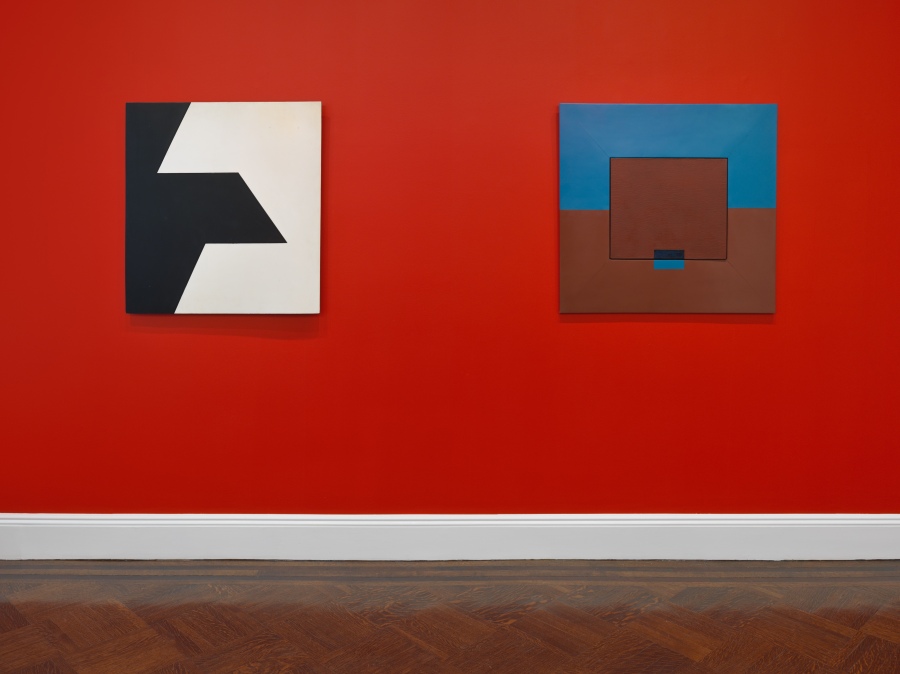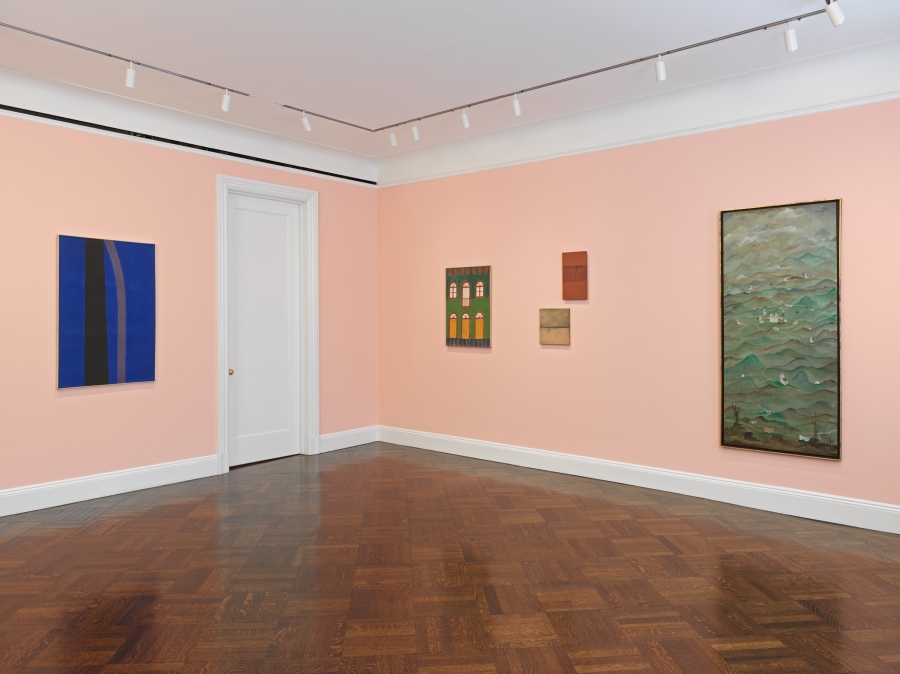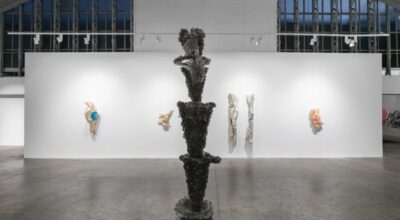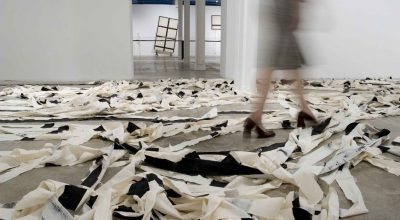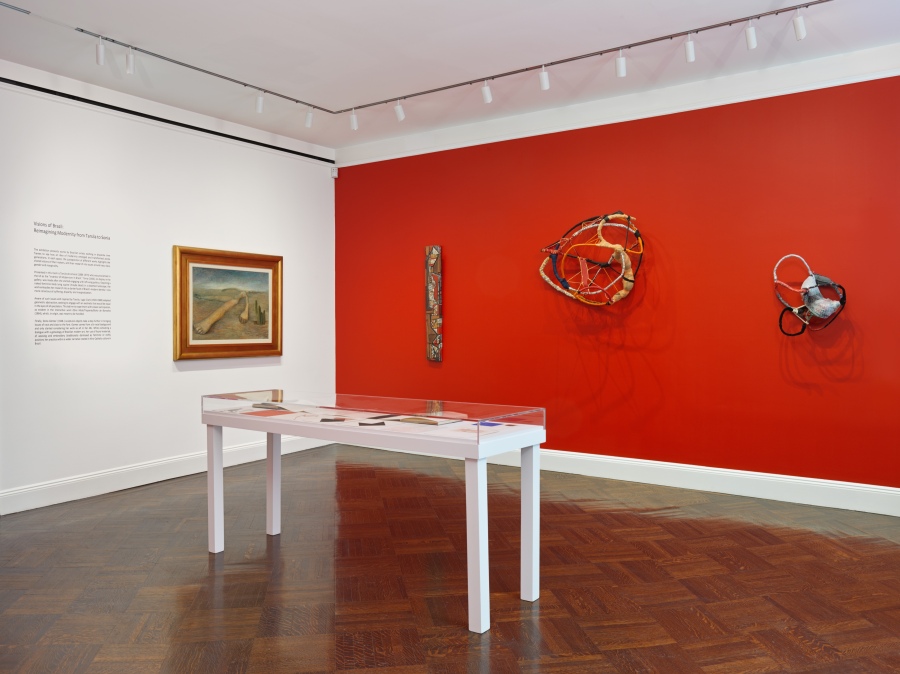
Visions of Brazil:reimagining Modernity From Tarsila to Sonia
“Our ways of knowing are forged in history and relations of power.”
— Bell Hooks
Blum & Poe New York presents Visions of Brazil: Reimagining Modernity from Tarsila to Sonia, curated by scholar and curator Sofia Gotti, hosted in collaboration with Mendes Wood DM. The exhibition gathers works that together span almost a century of Brazilian art, from Modernism to the present day. It positions itself as a cartography for navigating current debates within the US and the Americas surrounding the formation of Modernism in Brazil.
Works by Tarsila do Amaral, Sergio Camargo, Willys de Castro, Lygia Clark, Raymundo Colares, Antonio Dias, Sonia Gomes, Alberto da Veiga Guignard, Leonilson, Hélio Oiticica, Lygia Pape, Mira Schendel, Rubem Valentim, and Alfredo Volpi trace this pluralist history that winds through anthropophagy, feminist agendas, Afro-Catholic cultural genealogy, and more.
Upon considering this collection of Brazilian works within the framework of modernity, the first issue exhibition curator Sofia Gotti seeks to address is the concept of modernity itself. Historian Walter Mignolo has made the persuasive argument that “modernity is the name for the historical process in which Europe began its progress towards world hegemony, it carries a darker side, coloniality.” If we understand Modernism as the cultural output of modernity, then using this label when analyzing Latin American art becomes problematic due to its colonialist connotations. Visions of Brazil seeks to “reimagine” the Modernist lens that defined a generation, a temporality, a utopian project, a philosophy, by presenting a rereading of this history tethering it to issues around race, power structures, and economics.
Tarsila do Amaral or simply Tarsila (as she is popularly known in her home country) is best known because of how she conjugated a Modernist aesthetic with her research into the roots of Brazilian identity, reflective of its folk and vernacular traditions. Curators Stephanie D’Alessandro and Luis Pérez-Oramas once proclaimed her the inventor of modern art in Brazil. One of Tarsila’s most iconic works, A Negra (1924), is seen in the foreground of the Manifesto Antropófago (Cannibalist Manifesto, 1928) by her husband Oswald de Andrade. Employing the concept of anthropophagy, this manifesto declared Brazilian culture as cannibalistic towards European culture: it devoured it, digested it, absorbed it, and reformulated it into something new. The Anthropophagous movement became a vital source for multiple artists of successive generations—most notably Lygia Clark and Hélio Oiticica, which explains why this phase of Tarsila’s work is so widely referenced.
The work by Tarsila on view for the initial segment of the exhibition—Terra, 1943—is a rare example of her output after the Anthropophagy movement. Specifically, in the years following 1933 the artist adopted an aesthetic closer to Socialist Realism. In 1931 Tarsila visited the Soviet Union and she frequented Communist Party gatherings in Brazil, which caused her to be detained by the authorities for nearly a month. Besides speaking to her leftist political tendencies, the works produced in this period also confront newer female archetypes through less than idealized images of maternity, orphanages, or seamstresses working. Such works were devoid of all those tropical attributes we see in the drawings on view that distinguished her older output. Through the changes in Tarsila’s work, we can make out how her vision of modernity transformed into one more conscious of class, gender, and race-related issues.
A pivotal step in the construction of a revised Modernist narrative has been offered by Pérez-Oramas as well as curator Paulo Herkenhoff who confer that Tarsila was amongst those who inaugurated the modern period in Brazil, while Lygia Clark brought it to an end by literally embodying Tarsila’s Modernist project through her practice. For Pérez-Oramas, “among the various manifestation of South America’s aspirations to modernity […] perhaps none is more fascinating than Brazil’s cannibalistic phantasmagoria, which becomes image in Tarsila’s work, then later becomes body in Clark’s.” Clark’s revolutionary insight into art’s transformative effects on the body and on consciousness is manifest in some of her earliest and iconic experiments with active spectator participation in her Bichos (1961-1963), and Obra Mole (1964), objects made of connected metal sheets or rubber devised to be manipulated by the viewer and to be unpredictable in their movements. If we consider this history rooted in politics, race, and class as the departure point for a narrative of Modernism, it is possible to argue that it did not come to a close with Clark, but that it remains an ongoing project.
Such discussions offer the perspective that certain socio-political and economic conditions do not allow for the full realization of that Modernist utopia imagined in the 1920s and 1960s, suggesting it may still be a work in progress. When we turn to the work of an artist such as Sonia Gomes, a new facet of this narrative appears. Gomes’ works are still entangled with certain aesthetic tropes contained in the practices of Tarsila or Lygia Clark, though she is the first from this group who is non-white, coming from a bi-racial background, and who did not train in Paris. Gomes makes her works by using fabrics found or gifted from friends and family. Her choice of materials is also a reference to her growing up in a town in the state of Minas Gerais, which has amongst the oldest traditions of textile production. Her research approximates Tarsila’s inasmuch as it draws from Brazil’s localized cultural makeup. Her works have a corporeal presence that engages and involves viewers. Yet, by employing techniques such as weaving and embroidery, and for using unpretentious found materials (traditionally dismissed as feminine or craft), Gomes’ work brings to light a wholly different set of references. Her practice is positioned at an important point of juncture where it embodies simultaneously different visions of modernity. When asked why she recognized her own practice as art so late in life, she explained that the conditions were not ripe to do so. In other words, her work could not have entered the cultural discourse at an earlier date because the transformative potential it was offering would not have been recognized.
Visions of Brazil: Reimagining Modernity from Tarsila to Sonia positions works by Brazilian Modernists (such as Tarsila and Alfredo Volpi) alongside others made by artists working outside of Modernism’s canonical time bracket (Gomes, Leonilson), allowing us to deconstruct what Modernism may stand for; and by rooting this rereading in politics, race, and class, we may support a visual narrative of Brazilian Modernism suspended on diversity and equality.
También te puede interesar
LYNDA BENGLIS: FROZEN GESTURES
Mendes Wood DM, en São Paulo, presenta la primera individual en Sudamérica de la influyente artista estadounidense Lynda Benglis (Luisiana, Estados Unidos, 1941), quien ha desempeñado un rol indiscutible dentro del arte contemporáneo a...
TODA PERCEPCIÓN ES UNA INTERPRETACIÓN: YOU ARE PART OF IT
La muestra Toda percepción es una interpretación: You are part of it, curada por Eugenio Valdés Figueroa y Katrin Steffen es, desde la entrada, una invitación a participar activamente, no apenas con el ojo,...
DIEZ GALERÍAS LATINOAMERICANAS EN ART BASEL 2017
Diez galerías latinoamericanas participan en la edición 2017 de Art Basel Basilea, que se celebra entre el 15 y el 18 de junio en la ciudad suiza. De Brasil han sido invitadas cinco galerías,...

